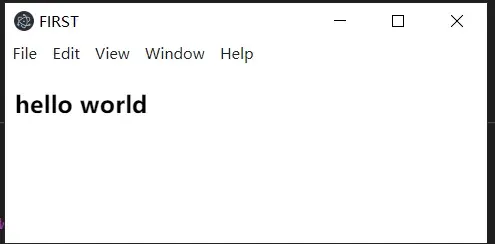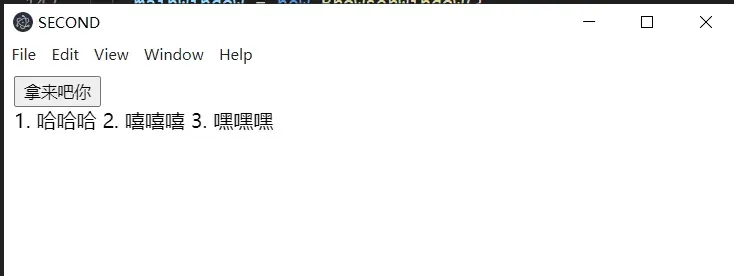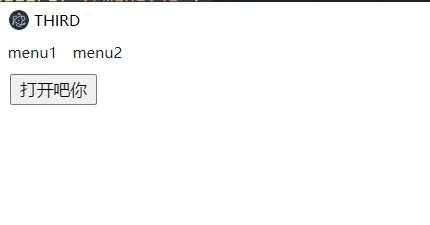Electron 是一个能让你使用 JavaScript, HTML 和 CSS 来创建桌面应用程序的框架。 这些应用程序可以打包后在 macOS、Windows 和 Linux 上直接运行,或者通过 Mac App Store 或微软商店进行分发。
通常,你可以使用操作系统 (OS) 特定的本地应用程序框架来创建一个桌面应用程序。 Electron 可以使用你了解的技术来编写应用程序。
Electron = Chromium + Node.js + Native API
Table of contents
Open Table of contents
安装 Electron
为您的项目创建一个文件夹并安装 Electron:
mkdir my-electron-app && cd my-electron-app
npm init -y
npm i --save-dev electronelectron 热更新/热加载
- 安装
electron-reloader
npm install electron-reloader --save-dev
- 在主进程 js 文件(main.js)加入如下代码:
try {
require("electron-reloader")(module);
} catch (_) {}- 重启测试,更改 js css html 等文件都能自动加载更新 electron
第一个 hello world
- 新建一个 index.html
<!doctype html>
<html lang="en">
<head>
<meta charset="UTF-8" />
<meta http-equiv="X-UA-Compatible" content="IE=edge" />
<meta name="viewport" content="width=device-width, initial-scale=1.0" />
<title>FIRST</title>
</head>
<body>
<h3>hello world</h3>
</body>
</html>- 新建一个 main.js: 主进程文件
// 引入 electron 模块
const { app, BrowserWindow } = require("electron");
let mainWindow = null;
app.whenReady().then(() => {
// 新建窗口,宽高为 200*200
mainWindow = new BrowserWindow({ width: 400, height: 200 });
// 加载 index.html
mainWindow.loadFile("index.html");
// 监听关闭事件,把主窗口设置为 null
mainWindow.on("closed", () => {
console.log("closed");
mainWindow = null;
});
});这时候打开终端,在终端里输入electron .就可以打开窗口了。

**注意:**检查 package.json,main 必须为主进程文件:main.js.(默认为 index.js)
附:文件结构
- node_modules
- index.html
- main.js
- package.json
- package-lock.json
或者
git clone https://github.com/electron/electron-quick-start
# Go into the repository
cd electron-quick-start
# Install dependencies
npm install
# Run the app
npm start读取文件栗子
- 新建一个 data.md
1. 哈哈哈
2. 嘻嘻嘻
3. 嘿嘿嘿- 改写 index.html
<!doctype html>
<html lang="en">
<head>
<meta charset="UTF-8" />
<meta http-equiv="X-UA-Compatible" content="IE=edge" />
<meta name="viewport" content="width=device-width, initial-scale=1.0" />
<title>SECOND</title>
</head>
<body>
<button id="btn">拿来吧你</button>
<div id="wrapper"></div>
</body>
</html>- 新建 renderer 文件夹,在 renderer 文件夹下新建一个 index.js
const fs = require("fs");
window.onload = () => {
const btn = document.querySelector("#btn");
const wrapper = document.querySelector("#wrapper");
btn.onclick = () => {
fs.readFile("data.md", (error, data) => {
wrapper.innerHTML = data;
});
};
};- 坑:控制台报错:require is not defined 改写 main.js
app.on("ready", () => {
mainWindow = new BrowserWindow({
webPreferences: {
nodeIntegration: true,
contextIsolation: false,
},
});
});这时候点击按钮

附:文件结构
- node_modules
- renderer
- index.js
- index.html
- main.js
- package.json
- package-lock.json
remote 模块
Electron 有主进程和渲染进程,Electron 的 API 方法和模块也是分为可以在主进程和渲染进程中使用。那如果我们想在渲染进程中使用主进程中的模块方法时,可以使用 Electron Remote 解决在渲染和主进程间的通讯。
- index.html
<!doctype html>
<html lang="en">
<head>
<meta charset="UTF-8" />
<meta http-equiv="X-UA-Compatible" content="IE=edge" />
<meta name="viewport" content="width=device-width, initial-scale=1.0" />
<title>THIRD</title>
</head>
<body>
<button id="btn">打开吧你</button>
<script src="renderer/demo2.js"></script>
</body>
</html>- renderer/demo2.js
const { BrowserWindow } = require("electron").remote;
window.onload = () => {
const btn = document.querySelector("#btn");
btn.onclick = () => {
// 打开新窗口
let newWindow = new BrowserWindow({
width: 400,
height: 200,
});
newWindow.loadFile("newWindow.html");
newWindow.on("closed", () => {
newWindow = null;
});
};
};- 新建 newWindow.html
<!doctype html>
<html lang="en">
<head>
<meta charset="UTF-8" />
<meta http-equiv="X-UA-Compatible" content="IE=edge" />
<meta name="viewport" content="width=device-width, initial-scale=1.0" />
<title>我是新打开的窗口</title>
</head>
<body>
<h2>我是新来的</h2>
</body>
</html>- 坑:改写 main.js
const { app, BrowserWindow } = require("electron");
let mainWindow = null;
app.whenReady().then(() => {
mainWindow = new BrowserWindow({
width: 600,
height: 400,
webPreferences: {
nodeIntegration: true,
contextIsolation: false,
// 需要打开
enableRemoteModule: true,
},
});
mainWindow.loadFile("index.html");
mainWindow.on("closed", () => {
mainWindow = null;
});
});这时候,点击按钮就可以打开新窗口了 附:文件结构
- node_modules
- renderer
- index.js
- demo2.js
- index.html
- newWindow.html
- main.js
- package.json
- package-lock.json
菜单基本使用
- 新建 main 文件夹,将 main.js 移至 main 文件夹下,主进程中用到的代码我们都写到这里 新建 menu.js
const { Menu, BrowserWindow } = require("electron");
const template = [
{
label: "menu1",
submenu: [
{
label: "新建窗口",
accelerator: `ctrl+n`, // 快捷键
click: () => {
var win = new BrowserWindow({
width: 500,
height: 500,
webPreferences: {
nodeIntegration: true,
},
});
win.loadFile("newWindow.html");
win.on("closed", () => {
win = null;
});
},
},
{
label: "menu1_2",
},
],
},
{
label: "menu2",
submenu: [
{
label: "menu2_1",
},
{
label: "menu2_2",
},
{
label: "menu2_3",
},
],
},
];
Menu.setApplicationMenu(Menu.buildFromTemplate(template));- 在 main.js 中导入 menu.js
const { app, BrowserWindow } = require("electron");
let mainWindow = null;
app.whenReady().then(() => {
mainWindow = new BrowserWindow({
width: 600,
height: 400,
webPreferences: {
nodeIntegration: true,
contextIsolation: false,
// 需要打开
enableRemoteModule: true,
},
});
require("./menu.js");
mainWindow.loadFile("index.html");
mainWindow.webContents.openDevTools();
mainWindow.on("closed", () => {
mainWindow = null;
});
});如图

附:文件结构
- node_modules
- main
- main.js
- menu.js
- renderer
- index.js
- demo2.js
- index.html
- newWindow.html
- package.json (注意将主进程文件路径修改为 main/main.js)
- package-lock.json
右键菜单
右键菜单的响应事件是写在渲染进程中的,也就是写在 index.html 中的,所以要是使用,就用到到 remote 模块进行操作了。
持续更新中…